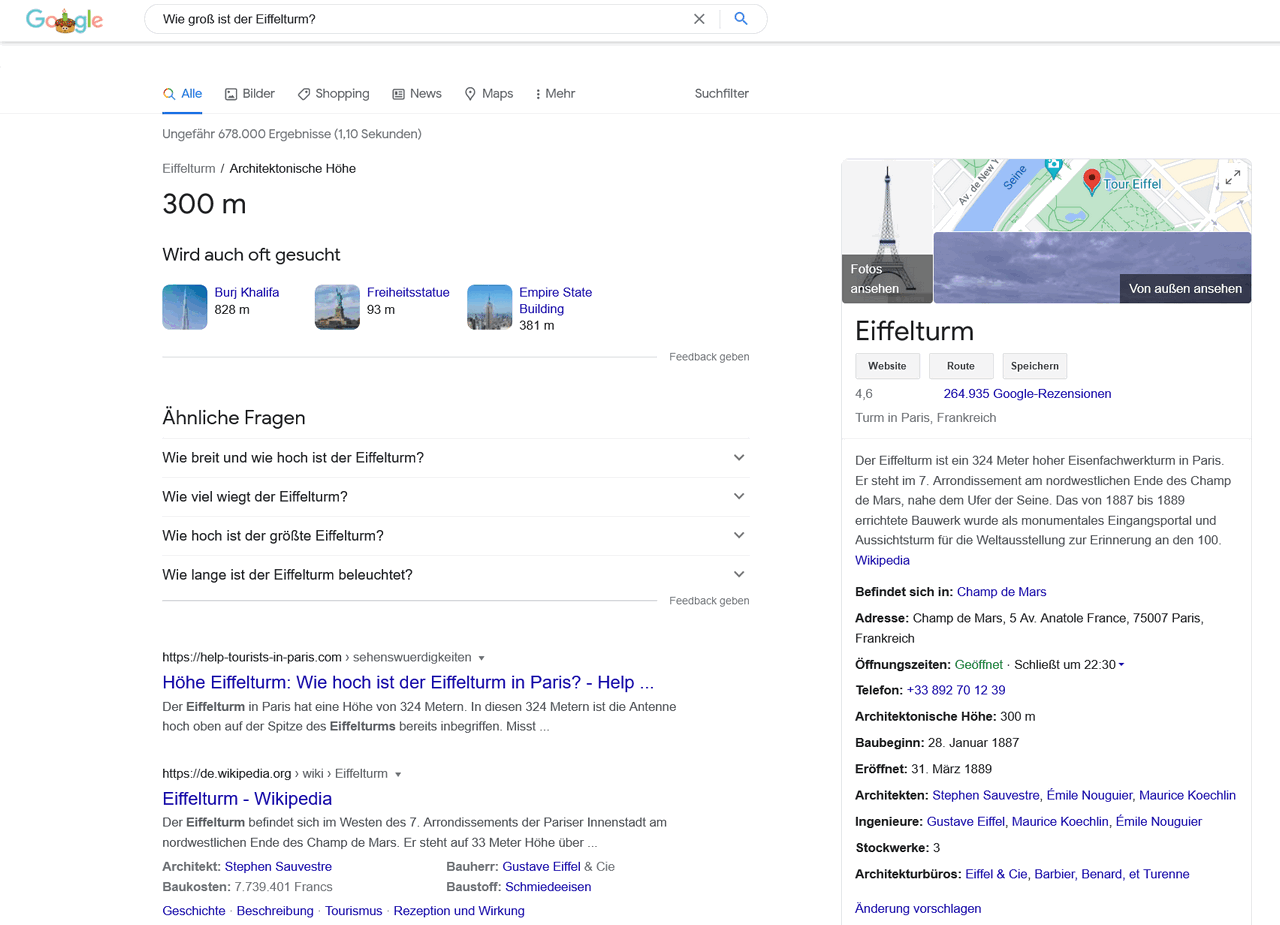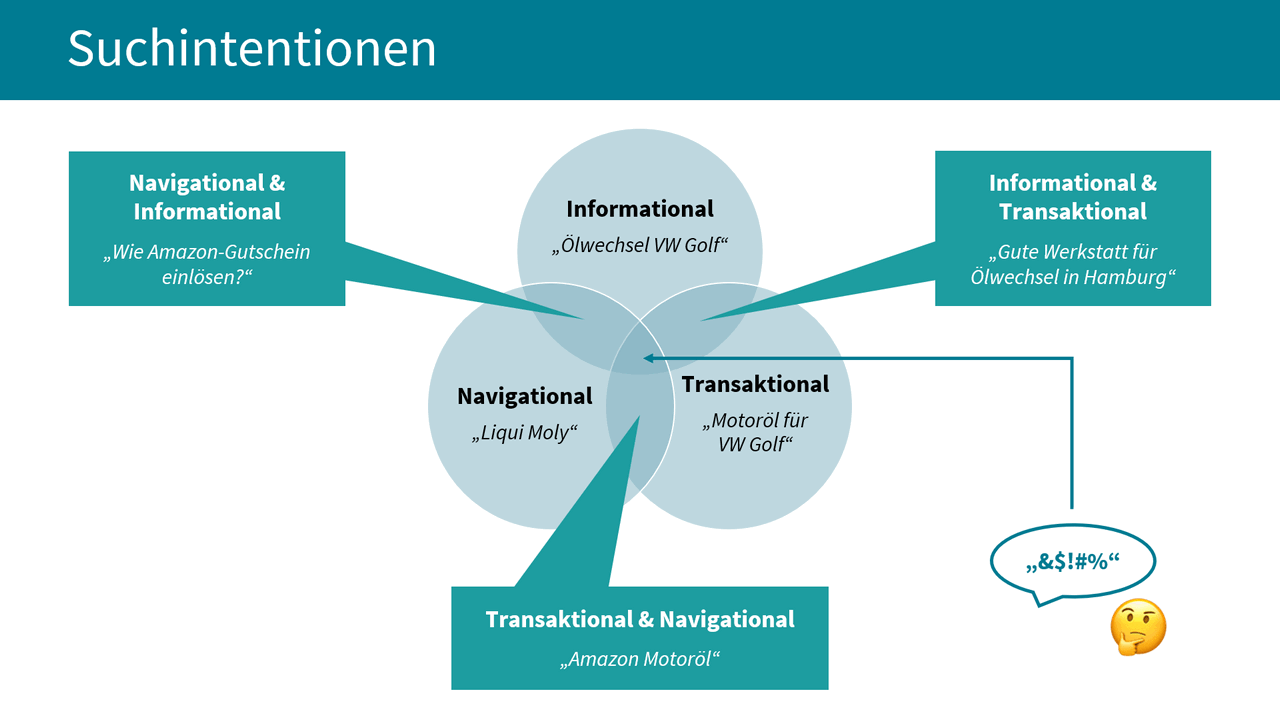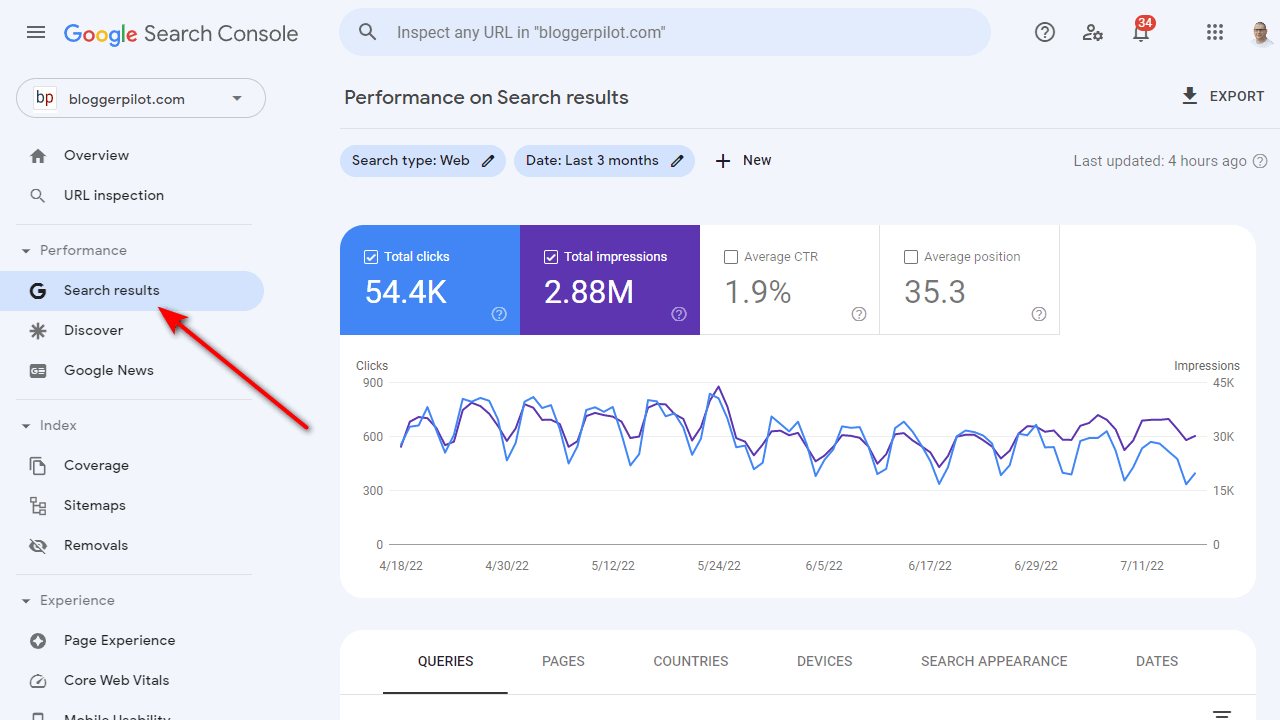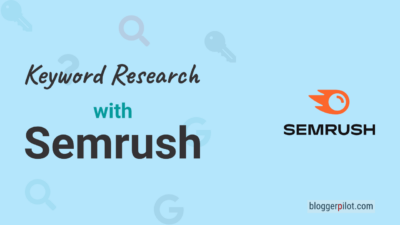Search Intent is the focus of SEO
Search intent helps you create relevant content. Learn why search intent is at the heart of SEO and how to analyze it. Nothing influences your site’s ranking more than high-quality content that satisfies your target audience’s search intent. It is a “law of nature” of search engine optimization that search intent must be the focus in order to sustainably increase the visibility of your website. Why this is so, which search intents there are and how you analyze them, you will learn in this guide.
Search intent, search intention or search intent is the term used to describe the purpose of a search query. It is the reason why someone performs a certain search. If you don’t meet that intent with your text, you have little chance of being listed for that search.
What is someone looking for when he types “bench” into the search slot on Google? Does he want to buy a piece of seating furniture? Does he want to build it himself? Does he just want to paint the garden bench? Or is he looking for a financial institution? Just to withdraw money quickly or to invest his assets? Or is it about the shoal in the sea – the famous sandbank?
Welcome to semantics – the theory of meaning. The above example illustrates the challenges that web search engines have faced since their birth. In order to deliver appropriate search results, they must understand the intention behind a search query. This is referred to as search intent.
Definition
Google
User Intent: When a user types a query, he or she is trying to accomplish something. We refer to this goal as the user intent.
Why is search intent crucial for SEO?
Search is not an end in itself. We all pursue a specific goal with a search query on Google. We want an answer to a question, a solution to a problem, or offers to satisfy a buying need. Not only for Google, but also for you as a website operator, it is elementary to know the intention behind a search query in order to be able to offer suitable content. Because this in turn is a prerequisite for a sale.
Everyone involved in a web search has the same need for relevant content. This is easy to understand for the user. If they don’t quickly find the content they expect using the search engine, they will look for another search engine. That is simply bad for business. Google and others want to display as many ads as possible above and below the search results and collect data about the users. And ultimately, you too are pursuing goals with your website that you can only achieve if you meet the needs of your target group.
The best content is of no use at all if it misses the search intent of your target group. At the latest through the user signals Google notices that it does not meet the expectations of the users, even if it may be linguistically brilliant.
Pages that ignore the user’s search intent will never rank well, will not get organic traffic, and thus will hardly contribute to the revenue goal.
Notice
It is the user’s desire to find content that meets their needs. It is Google’s intention to provide search results that satisfy the user. Therefore, it should be your effort to provide content that matches the search intent of your target audience.
If a user is looking for how to change the engine oil in his Opel Corsa, then it makes little sense to offer him offers to buy engine oil. A comparison of different brands would therefore not be content that ensures a good ranking.
Sell via the search intent
However, with a guide that shows step by step how to change the engine oil in the garage at home, you reach the user at the point in the customer journey where they are at the moment, because you fulfill their specific search intention.
So you still have a good chance of selling them engine oil or accessories for oil changes via the guide content, for example by making them aware that they need an oil pan and a new sealing ring before they can start changing the oil. This information will not be seen as a clumsy sales attempt, but as useful information and will be rewarded with a higher level of attention and willingness to buy.
What is the difference between search intent and user intent?
Often, even self-proclaimed professionals use the terms search intent and user intent interchangeably. Yet there is a subtle difference. User intent is the overriding motive that leads a user to make a search query.
| User Intention Overriding motive | Search Intention Intention of the search query |
|---|---|
| Book rental car | “Provider car rental Mallorca” “How big should a rental car be for 4 people?” “Which insurance makes sense for rental cars?” “Experiences with Sixt” |
Each user intention goes along with a search intention. The search intention results from the user intention and describes the intention behind a specific search query. If you want to serve the user intention, you have to derive it from the search intention and create corresponding content.
Which search intentions should be distinguished?
Andrei Broder at AltaVista, one of the first search engines with full-text search, developed a taxonomy for search terms back in the early 2000s that distinguishes three different types of search queries based on the intent behind them:
- Informational search queries
- Transactional search queries
- Navigational search queries
Informational searches
Informational searches are triggered by a need for information on the part of the search engine user. He either has a question and is looking for an answer, a problem and is looking for a solution or wants to systematically acquire knowledge.
Indicators within the search query for an informational search:
- Question words and question marks: What, Why, Why?
- Definitions: Definition homonym, What is a synonym?
- Guide: Installing operating system, How to replace faucet, Tips for hedge trimming, How to change car battery step by step, FAQ for dismissal, Guide for appraisal interview, Help repotting flowers
- Inspiration: Ideas autumn decoration, Example wedding invitation, Suggestion notice formulation, Top sights Manhattan
Informational searches usually take place at an early stage of the customer journey. At this stage, users are often not even aware that there is a solution to their problem, let alone what it is. Tailored content can be used to direct them to suitable products or services without appearing to be heavy-handed advertising.
Information-oriented searches make up the majority of search queries on Google and Co. Users seeking information often look at several websites from the search results.
Transactional searches
In transactional searches, the search engine user wants to perform a specific action. Examples are:
- Buy or order a product
- Reserve a table at a restaurant
- Create a website
- Hire a plumber
- Make an appointment with a hairdresser
- Send inquiry, request offer
- Subscribe to newsletter
- Watch video
- Download file
Transactional searches take place at a later stage of the customer journey. The user already has a relatively concrete idea of what he wants. Therefore, traffic generated through transactional searches is much more likely to lead to a conversion. Transactional searches are therefore particularly lucrative and are characterized by a higher proportion of paid ads in the search results.
Transactional searches are often equated with commercial searches. However, this is wrong. It is true that a commercial search query is always also a transactional search query, but not vice versa. After all, there is an action behind watching a video or downloading an authority form, but not necessarily a commercial interest.
Navigational searches
As the most important search engine, Google is the gateway to the Internet. Many use the search engine – consciously or unconsciously – to navigate the World Wide Web. Entries such as “Amazon Login”, “ZDF Mediathek”, “web.de” or “Zalando Schuhe Herren” are not at all uncommon and merely pursue the goal of calling up a specific website. A special form of navigational searches are brand keywords such as “Bild”, “Adidas” or “YouTube”.
Navigational searches are characterized by the fact that users usually only make one click (on the first position) in the search results.
Search intentions at a glance
| Informational | Transactional | Navigational | |
| User intention | Find information, acquire knowledge | Find offers, perform action | Go to a website or webpage |
| Expectation(s) | Answer to question, solution to problem, definition, instruction, guide, etc. | Product offers, possibility to contact, download, etc. | Reach target page quickly |
| Special features SERPs | Google OneBox,Featured Snippets,People also ask | Google Shopping, relatively many ads | Target page is usually on position 1 and is clicked on immediately |
| Good to know | accounts for the majority of search queries | high chance of conversion (lucrative) | usually only one click in the SERPs |
Explanation: SERP = search results page
Search intentions according to Google
Google itself redefined search intentions a few years ago and wrote them down in the Search Quality Evaluator Guidelines.
| Intention | Examples | |
| Know | Get information (answers, solutions, knowledge) | “What is liability insurance for?””How long does cherry blossom last?””Where is Buxtehude?” |
| Do | Perform actions (order, reserve, request, download, etc.) | “Buy ball gown size 42″”Book train ticket””Download Microsoft Word” |
| Website | navigate specifically to a website or webpage | “YouTube””canon.de eos””GMY Login” |
| Visit-in-person | visit physical location | “ATM Prenzlauer Berg””auto repair shop Münster””ophthalmologist Mitte” |
Know Simple type queries are a special type. These are very specific information searches, which can be answered concretely in a small space. Google answers such queries more and more often itself and wants to push the change from a search engine to an answer engine. The disadvantage for webmasters: only a few users then still call up the website from which the information originated. The subsequent search results also receive little attention. In this respect, SEOs must still try possible to provide this answer to be noticed at all.
Examples of know-simple queries:
- “Age Angela Merkel”
- “Inhabitant New York”
- “Size of Saarland”
- “How much is 100 CHF in Euro?”
Google provides the answers in the highlighted OneBox or Featured Snippets. These attract more attention than the normal search results. So, the goal should be that your website is displayed highlighted. However, as a rule, only one page will be. Namely, the one that delivers the best result for the search query.

Typical example of a Know Simple search query that Google answers directly in the search results.
Mixed Intent: Ambiguous Search Queries
Search intentions are not always clear. Certain search queries suggest different search intentions (mixed intent). In this case, you should also try to satisfy both needs with the content. If you succeed in covering several search intentions, your visibility in the search results increases, because ideally, you rank for queries with different intentions.

How does Google recognize search intent?
As you will have noticed from your search queries, Google has a pretty good semantic understanding by now. Although each keyword brings up millions of results, the websites that best satisfy your need are usually at the top. Even if the keywords are homonyms (opposite of synonyms) like bank. In other words, words that have entirely different meanings.
If a search query contains certain words, this makes it relatively easy to deduce the intention. “Paint with which wall color?” is already an informational search due to the question word, while “buy wall color” is clearly a transactional search due to the second word. If the search query is not so unambiguous, personal data that Google has from its users often helps.
For example, if I am interested in cars and regularly search on the topic complex, Google will show results for “Jaguar” on the car brand rather than the animal.

If a typical local search term such as “bakery” is searched for, Google also uses my location and displays libraries in the vicinity of where I am or where I live. Here we then speak of local search results.
Nevertheless, Google does not always succeed in matching the search intention – after all, 15 percent of daily search queries are completely new. They have never been asked before! If the search engine cannot recognize the search intention, the reasons include the following:
- Lack of focus
If concise, generic search terms are used, such as our opening example “bank”, Google has difficulty extracting the search intention. Especially when little personal data is available and can be used for interpretation. - Differences in meaning
Not everyone can find the right wording for a search query – especially since there are regional differences in the meaning of words. For example, while people in Germany speak of vacation, the Swiss speak of vacations. If a search is made for vacation in Germany, however, it is not vacation that is expected, but rather school vacation times. Another example: the deep-fried doughnut with powdered sugar is called “Pfannkuchen” in Berlin. The rest of the country, however, understands Pfannkuchen to be the German equivalent of the French crêpe. - Dynamics
Things change – and so do search expectations. If you searched for “President USA” before the 2021 presidential election, you expected to find information on Donald Trump. After that, on Joe Biden.
Notice
The longer/detailed a search query, the easier it is for Google and for you to deduce the search intention behind it Long Tail Keywords are therefore easier to interpret than short head keywords
How can you tell the search intent?
So before you start producing or commissioning content, you should look at what your target audience’s search intent is and what search queries match that search intent. Answering this is the task of the famous keyword analysis.
If you have a certain keyword in mind and want to know what search intent is behind it, the easiest way is to search for it on Google and see what the Search Engine Result Pages (SERPs) look like:
- Wikipedia far in front, Knowledge Graph, definition box, FAQ and videos speak for an informational search, for example
- Google Shopping, Local Pack, product and brand images, links to online stores and many paid ads speak for a transactional search intention
To find out with which search intention visitors come to your website, you should have a look in the Google Search Console under the menu item “Google Search Results” (formerly “Services”), which are the most common search terms used by your visitors.

If you click on the search term, Google will provide you with more information about your performance. Under the “Pages” tab, for example, you can see the pages that rank for the search term, how often they are displayed and how often they are clicked on. A low click-through rate is an indication of a missed search intent. Other user signals such as low dwell time can also indicate this. These key figures can be taken from Google Analytics, for example.
A good keyword research helps you not only to determine the search intentions, but also to find niches where high-quality information is still scarce. In these niches, you can make your mark with relatively little effort and quickly build organic traffic.
If you already have content, you don’t necessarily have to change the main keyword to align the text with the search intent. Typically, a few rwcordings and additional information can help. In the future, you should always perform an analysis of the search intention before producing new content, to save content that does not perform anyway.
Automatically detect search intent

Especially in keyword research, you often want a list of keywords with a specific search intent. To clean up a really long list manually is tedious and time-consuming. The remedy is the right SEO tool, which automatically detects the search intent.
I use Semrush for this. Directly in the listing, each keyword is marked with the letter I, N, K or T, which is the abbreviation for the respective intention.
If you want to filter only by an intention, you do it via the filter above.
Conclusion: Only those who know the search intention can perform effective search engine optimization
The topic of search intent is not a nice-to-have for webmasters, but a must!
Only if you know the motivation of the searchers, you can create content that offers added value and relevance. And only this content has any chance of a good ranking. If you understand how Internet users search and how Google assesses relevance, it’s easy to satisfy the needs of both sides.






